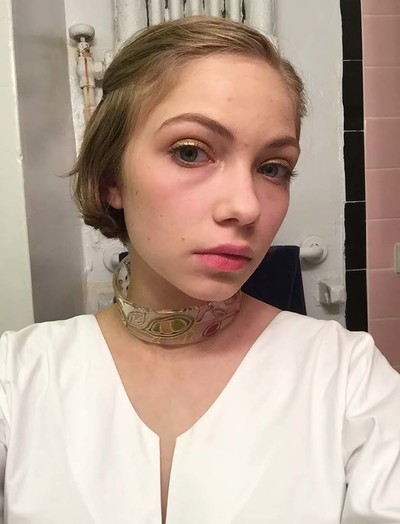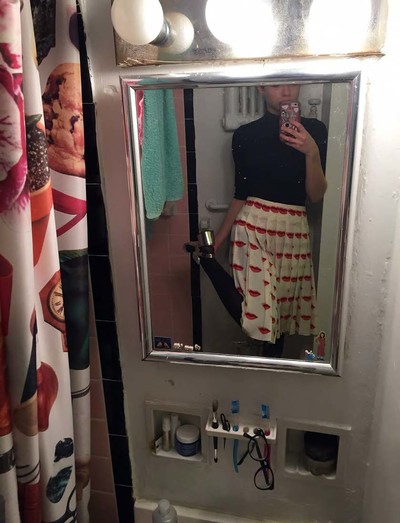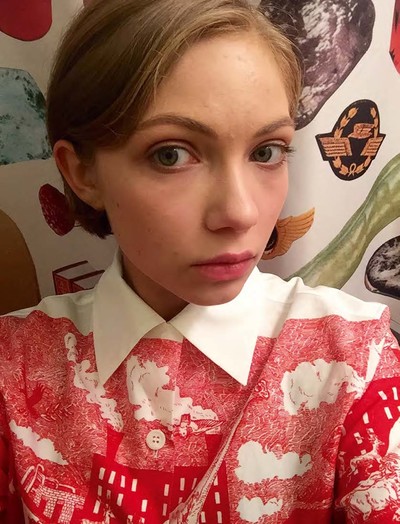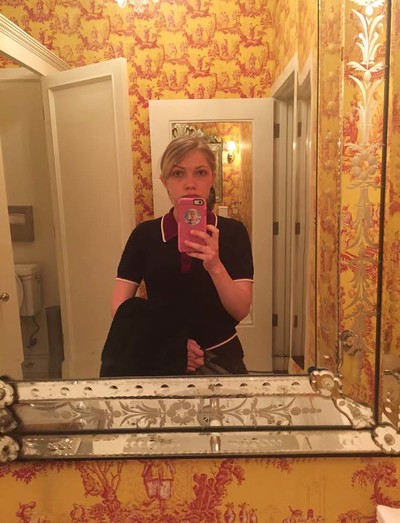Miuccia Prada tells Tavi why femininity means more than just girly motifs or womanly silhouettes.
By Tavi Gevinson
Miuccia Prada tells Tavi why femininity means more than just girly motifs or womanly silhouettes.
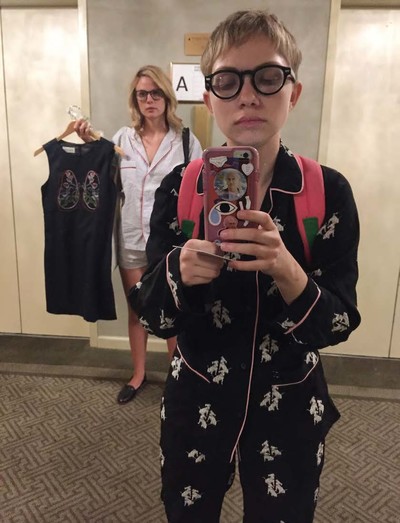
Wandering around a hotel in my Miu Miu pyjamas with my friend.
Miuccia Prada’s appetite for the irreverent is as present in conversation as it is in her work. When we spoke over Skype this past July, every other sentence contradicted the last; ‘I shouldn’t say that!’ became a form of punctuation. Watching her play devil’s advocate with herself, it became obvious how she generates so many new ideas every season. As she discovered different rabbit holes to go down and opinions to try on, I was reminded of my favourite unexpected Prada and Miu Miu moments from over the years: the sailor hats, the clip-on journals, the naked-lady collars, the Mohawk shoes, the fairy-tale pyjamas. This regard for nuance is how I know, when I wear her clothes, that a woman designed them. Prada’s concept of femininity isn’t restricted to girlish motifs or womanly silhouettes, unlike so many ‘feminine’ markers historically defined by men. She often examines and embraces such elements, and I absolutely identify with the concept of womanhood expressed in her subtly off-kilter details. Those possibilities so often left behind when design conventions are taken for granted; the clothing equivalent of ‘on the other hand’, another prominent feature of our conversation.
In the age of the personal brand, style has become a way to simplify, and then advertise, who we are. Miuccia Prada would prefer that it make room for all the selves we forget to be. To explore the facets one is accustomed to muting because they pose the threat of paradox. Revisiting our interview, I’m struck by one of her only consistencies: a repeated emphasis on what’s ‘more real, more personal, more human’.
Tavi Gevinson: How has your concept of your job to dress women changed over time?
Miuccia Prada: Personally, I grew up in a moment that was much freer, much simpler and more fun and exaggerated – more interesting. Recently, the pressure has become a little bit heavier. Fashion reaches so many more cultures, which is good in a way – you have to deal with different cultures, different races, different stories. That is what makes my work more exciting. At the same time, there was a freedom that we had back then, probably because it was more for an elite; until the 1980s, the people who wore these clothes were white, rich, sophisticated. It was a small world, so you knew exactly who your audience was, who you were talking to. You didn’t even ask why because it was just for you, and the people sitting next to you.
In a way, that was much easier, but the world became more globalized. It became more interesting, but somehow more political, because you had to do what you thought was right and be general about it. I think that I want to go back to the way I used to get an idea: more human, more yourself, more real. So this idea of the brand covering the whole world is good and bad. It’s bad because the work becomes more abstract, but at the same time, more interesting.
Right. On one hand, you have consumers to cater to, but on the other, they’re there for your point of view, not for you to do what you think they want to see.
No, but I never work thinking what other people want, because I’m not able to. Because I never had a muse; I’ve never thought about my customers. I’ve always done what I thought made sense. And placed myself as the opposite gender: If I were a man, what would I wear? That’s always very personal. For example, this last show was very odd. It was about memories that only happen to women, and I had this sense of what women have had on their shoulders, like political issues. I tried to depict the difficulties and complexities, but also the beauty of women. But since then, because I went through all this analysis, I’ve wanted to go back to something more real, more human, more today. I think I’ve finished this work of analysing women’s situations and histories, but I’m reacting now, and at some point you need a period of things that come from your mind: the human, private, real.
‘I’ve never had a muse; I’ve never thought about my customers. I’ve always done what I thought made sense. Like, ‘If I were a man, what would I wear?’’
There are all these different archetypes of the roles women have been expected to play or have played throughout history in your work. It reminds me of Carl Jung and the idea that all people already contain all these different archetypes inside of them –
Absolutely.
– and in the psyche. Does fashion allow you to try out those different roles?
Completely. What interests me, 100 percent, is women’s lives. The lives of different people. I love even my real life, too; I have so many different ways to behave. I like to play with all the different possible ideas of a woman and to use them, so the clothes are what help you in this kind of expression. Fashion is to help you express your different selves. That, I think, is the interesting part of fashion basically. It should help your life.
I like too the idea that one doesn’t cancel out the other. You can be all of them, and every day, you can choose a different one.
I couldn’t agree more. It’s the pleasure that women can find in possibilities. Sometimes it’s preferable to do 10 different things badly than only one well. I have women friends who decided no family, no men, no this or that. And I prefer to be a bit of everything! But many different things. That variety is also really linked to me as a person. The moment I say red, I mean black, and the moment I say black, I also want pink. I notice there is not an opposition. I see the possibilities women can assess, because the female mind is more complex. Perhaps women still don’t rule the world, are still in an inferior position – it’s a complicated situation, but I’m being simplistic – because they are more complex. And command is easy. If you want to command directly an idea, it’s, ‘Yes, no, white, black’. Women say, ‘Yes, black! But’!
And I think that’s valued more in most professions, to have straightforward answers rather than ambiguity. It’s almost like there isn’t time to celebrate the benefits of having an answer that’s more like, ‘Yes, black! But’.
Do you prefer when someone says ‘black-black’ or ‘black, but’?
I prefer ‘black, but’!
Me too! But this is why we look less strong, because we are more ‘but’; we are more complex, but also more articulate.
‘It’s better to do 10 things badly than only one well. I have women friends who decided no family, no men, no this or that. I prefer a bit of everything!’
To me it’s a strength to say ‘but’, to find all the different angles! But that’s not how so much of the world functions. I was talking about this with an actress in a play that I’m in. American directors and casting directors are like, ‘Who are you, what’s your deal, give us your story, tell us who are you, just summarize it’. But Europeans want to have a conversation; you say something and they think about it, and then they respond.
Yes. So much. To describe another person with a few words is impossible. It’s reductive. It is offensive for a human being. So sometimes maybe they criticize me because I change so much, but changing is what I am, and if you are going to explore different possibilities, it’s always within yourself. I still want to go to the new and what’s next and what’s more interesting. So I don’t know if the constant change is an advantage or disadvantage, but I am only me, so…
I think we’re moving more and more towards everything needing to be reduced and simplified and easily described. I think that’s the way of the news cycle and media, and how people receive information. Do you find any pressure to simplify the Prada brand or say, ‘The Prada woman is…’?
Completely. Completely. That’s why I brought it up in our discussion – sometimes I am criticized because I am changing too much, and that’s too complicated. I really believe simplification, in this moment, is a very, very bad thing. It’s a problem, but I’m deeply interested in it. People have too many messages, too much to look at, too much to see. I’m not just talking about fashion, I’m talking generally. We are so bombarded. At some point you need some clarity, so you need to reduce. Because it’s like constant information. So I understand the need, but I think simplification is only good until a certain point. It can become banality.
For instance, we did a show at the Fondazione with an artist called Nástio Mosquito. And I was very surprised because he said, ‘Why are clichés considered dumb? Clichés are fantastic! It means that it’s something that everyone feels’. He’s a young artist, a black artist, very, very good, and all his show is based on clichés and proverbs. Because if something is so repeated and so common… This is why I think restriction and simplification is really something to be analysed.
There’s something great about the way clichés or proverbs create a common language. I wonder what you feel you’ve learned about women and how they want to see themselves by what’s been most popular at Prada over the years.
I would have to say they love simplification. In my past, many years ago, there was more subtlety. Now this problem of simplification started to really, not bother me, but engage my deep interest. Is it good or is it bad? How can I use it? Sometimes I start using it, but then I go in the complete opposite direction. I couldn’t care less about this problem; I just do what’s more personal. This last show was this history of women, but even that, it was a concept. It was the rose; it was all a symbol of that, let’s say, banality or cliché. So I don’t know if I want to go on exploring that or just start something from scratch because it’s more real, more personal. Who cares what women like or not? I could just do what I feel!
When there’s more diffusion of culture, there’s less space for niche. One of the reasons why I’ve decided I really like to grow is because it poses different questions. The niche I know so well, so much, it is not that interesting. It would be very easy for me to cater to a niche, but I like to challenge myself with a wider audience, a wider group of people, different from me. Because I think that from them, I learn so much more.
What do you feel you’ve learned about designing for women from that experience of trying to reach people outside of the niche?
To be honest, when I do shows, I just do what I like and think is right for that moment! Even if a wider audience is in the back of my mind. So your question is very relevant, because probably it is a very political proposition or concept. But actually, I rather like it that when I do the real fashion or the show and I go by instinct. How much these theoretical thoughts have influenced my work, I don’t know. It’s funny, actually, it’s the first time that I think about that. That I talk about this theory, but when I work, I do the opposite.
I’m sure it finds its way in somehow. It’s informing something.
Yes! Completely. Somehow it will inform the instinct, I’m sure, because it’s something I’m really curious about.
‘Sometimes people think, ‘What can I do to be more elegant?’ Be yourself, and afterwards, the problem doesn’t exist. Because there are no rules.’
I’m always surprised by what ends up resonating with people emotionally, and you can’t really predict it or control it. You can’t decide that you’re going to get through to a group of people, and then do it for them, and get the result you want.
I agree. I always say that I don’t have a muse. In the end, I’m not able to reason in terms of… really thinking about the result. Sometimes people think, ‘What could I do to be elegant?’ Sometimes I say, ‘Study, study’. OK, what does that mean, study? Study fashion, study movies, study literature, psychoanalysis. Be yourself, and afterwards, the problem doesn’t exist. Because there are no rules. So one should do what one feels. So, of course, I tell myself if I do a thing that has to do with people, like a collection, it’s impossible for me to do things that I don’t like. I am not able to give someone a present if I don’t like it. Say a friend of mine likes roses, but let’s say that I don’t like roses – I can’t give her something that I don’t like. I struggle with it myself. I see that mainly when I do presents; I can’t buy anything, even if I know they’ll want it more than anything, if I don’t like it. It is a weakness and it is a strength.
What’s a good present for you?
Anything. Anything. Because I like so many different things, in so many different fields. But you know, you can feel when something is not for you. I have to say that, now that I talk about it, the presents that I receive are usually always good.
Presents are hard for people with impeccable taste. I run into that problem with my friends I really admire.
I know, but I can give you the solution: give what you like. Don’t think what they like. That’s easy. Then it can’t be wrong. Because it’s a piece of yourself.
You talk about women’s roles throughout history, and many of the collections have modernized some of those archetypes we were talking about before. More and more recently, people – and people in fashion – have been talking more about gender fluidity, and having more freedom in gender identity. It’s modern in a different way. Is that something you’re ever compelled to engage with through design or feel Prada is a part of?
I have this problem much more when I do the men than when I do women’s. I always thought that they had less freedom than us. I was trying in a subtler way to change the rules, if not in a violent way. Maybe now it’s changing, but for years, if you experimented with men’s, you were not ‘believable’. So I wanted to do small things, make small progress. The size of that – for sure, it’s much more your subject – but looking at clothes, it’s still not that much freedom. Last night I watched the movie Alexander the Great, with Richard Burton. And the way men were decorated! Even 100 years ago, in the late 19th century, the way men dressed – jewels! It’s just curious to think about, that it feels like a new revolution, but in the past men were dressed up so much more than women.
And pink was originally for boys!
Pink and lilac! But I am more interested in the limits. Whatever the gender, I feel so much that everyone knows what they want, so with dress they should have that total freedom. As a designer, I am more interested in the limitations of the way men dress. There are so many limitations. Because the edge of the ridiculous is still very… The more of a snob they are, the less they dress up in what they like. It’s true! They want to be sophisticated; they want to hate fashion. For my real taste, I like not too much dressing up. But more for men than for women. For women, I always love dressing up. But it’s difficult to find men where there’s much that’s interesting. I shouldn’t say that!
So it’s more about working within the confines of what’s been established as acceptable for men?
They have too many limits, but I think that it’s a process. It’s funny because for many years, I was criticized, I remember, for putting men in stuff that was not for men. One show, it was kind of a skirt on top of trousers. And the trousers had no opening. And I said, OK, let’s call this a big belt! Because I like to play with rules, but look like I’m not breaking them. ‘No, it’s not a little skirt! It’s a big belt!’ Mainly at the beginning of my career, but probably also now, I would wonder what about a classic look is also profoundly disturbing. For the so-called avant-garde, it was obviously not avant-garde enough. Because I like going to that kind of subtle part. Sometimes I analyse things and think, ‘Why would they make a scandal about that kind of little belt?’ But the show has the most incredible stuff, because I am serious about really trying to break some rules. These choices are small, but probably more relevant than bigger ones. I like to do something that doesn’t look like change, but is.
‘The most fun I have is when I debate with myself: Why is Prada sophisticated? Let’s make it stupid! Why is Miu Miu playful? Let’s make it smarter!’
Right. And part of why men have more limitations is because they’re not allowed to look at all feminine.
Yes, for sure. So in the design I think about eccentricity and colour, because it’s about freedom. You should be able to have whatever you want because you are free, not because you are worried about gender. You’re a person, you have to be free. Those who oppress you – you have to do what you want.
Right! Sometimes it’s not even about looking feminine, just being clear that a garment had a little extra care put in. Then it’s like they care too much, and that’s feminine, to care about fashion or appearances.
Yes, but why? This is another big, big, big subject. I know many people who would love to work in the fashion world, but in the end, they think it’s a job for women. So many young people, the ones that really tell the truth to me sometimes, deep down, they think the fashion world is the most magnificent, the most exciting, the most open place, where you get to meet all the best people from movies, art, and so on. And so they would love to do it, but they still don’t do it because it’s a woman’s job. We still have a long way to go. You and me are privileged, but out there, women are facing social and economic problems…
I find that fashion designers’ ideas of beauty are actually so different from the standard of beauty in mainstream America. Like when it’s the Oscars and all the girls wear these really beautiful dresses, all the fashion people I know are like, ‘Ugh, boring’.
Absolutely. That is an example of how a cliché can be bad, when it only means being super normal.
It’s very limiting. You have to be very normal.
All my career I’ve struggled against that. I never did a bias dress because what I did more is about the cliché of it. Women want to see that kind of beauty that is so imposed, so impersonal, that I don’t find it beautiful. But I was very much criticized because I wanted to introduce in the clothes what was happening everywhere. In the art world, design, movies. But fashion said no. Still those rules were everywhere. Beauty rules are still very old-fashioned. We progressed a little bit, I think, in the 1990s. Now, since the beginning of the 2000s, we’re really going backwards. The cliché of beauty is now getting stronger and stronger. Something that was normal in those years – I wouldn’t even call it avant-garde, just challenging a different way of being, much more complex, much more interesting, much more real, much more fun – now, it’s not the best. But I hope that there will be a new change. Maybe we went too far and now we will go back.
You’ve toyed with these clichés of beauty, but then there are occasionally collections where you have said that you’re trying to go back to this pure idea of beauty, that exists in the psyche. The kind that you would recognize in nature, or the same kind that people might have recognized years ago before being influenced so much by external ideals. From the time I grew up in, and how many images I’ve been surrounded by, I think today it would be harder for someone my age to be able to make that distinction between contemporary ideas of beauty that have been perpetuated by media and clichés, and then some type of ‘pure’ authentic beauty. Where did it come from for you? Does that make sense?
Yes, that is very, very interesting. I never thought about why – probably my education – I had an idea of what beauty was and how to break the rules, and now what is classic beauty? Maybe it is the Hollywood, Oscars kind… But I’m really interested in what you’re saying because it’s true. To a younger generation with so much information, which is the one that fits beauty?
But you can only think about your own ideas of it?
Yes, I think I feel the pressure, but in the end, it doesn’t make any sense to me because there’s nothing I can do with it.
Does Miu Miu function as a way to present a different idea of womanhood from Prada?
When I started Miu Miu, I always said the distinction was – because Prada somehow was more serious, more thoughtful, more intellectual, let’s say – Miu Miu was another part of myself, more fun. So it’s another way to express the differences I have with myself. Sometimes no one knows which one is which, because I do Prada like I should do Miu Miu, and I do Miu Miu like I should do Prada. But if I do that, they tell me, ‘See? You confuse people!’ [Laughs] So probably this is the first time that I say it in public. But it’s a part of me. Miu Miu is more improvised, more special, lighter, more instinctual.
I think part of being playful is trying to see what it’s like to feel serious. And part of being intellectual is to see what it’s like to be more playful. So those tendencies make sense for both sides of being a woman.
Thank you for analysing it because I am so happy you say that. That consoles me!
Good! The smartest people I know, the most Prada people I know, know that you need time to play and to feel like a child and to not think! They know you need Miu Miu in your life, too!
[Laughs] Completely, yes. It’s nice to have both. Otherwise, my constant complex is the end of curiosity, so at least now there are different places to go. The most fun I have is when I debate with myself: ‘Why is Prada sophisticated? Let’s make it stupid! Why is Miu Miu so playful? Let’s make it more smart!’ That’s a game I play with myself!
